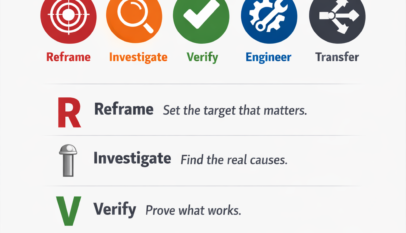Electrical and Sensor Module Objectives
This module provides a basic electrical safety awareness and NOT technical electricity training.
The module will provide the tools and ideas on what to do in case of electrical fire, what to visually inspect, and the abnormalities you may encounter in the plant.
Operators will be able to inspect for electrical abnormalities, properly use cycle stop and emergency stop, and do the basic alignment procedures with sensors on the equipment. Operators will be able to find abnormalities that include frayed wires, cracked conduit, and test for broken and nonfunctioning sensors on the equipment. The module will give you the knowledge to help you perform your TPM inspections.
Basic Function of Electricity
Electricity is the main power source for the operation of equipment.
Use of Three-prong plug and polarized plug
The third prong on a three-wire cord set provides a path to ground for electricity that is straying or leaking from a motor. This helps protect the equipment and can help prevent electric shock. A polarized plug is a plug with one large or wide prong and one narrow one. It ensures that the plug is inserted correctly in a socket and reduces the risk of electrical shock.
Use of Ground Fault Circuit Interrupter
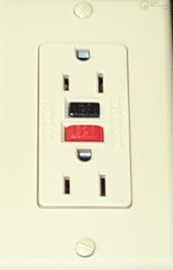 A Ground Fault Circuit Interrupter (GFCI) is an electronic device for protecting people from serious injury due to electric shock.
A Ground Fault Circuit Interrupter (GFCI) is an electronic device for protecting people from serious injury due to electric shock.
GFCI constantly monitors electricity flowing in a circuit.
If the electricity flowing into the circuit differs by even a slight amount the GFCI will quickly shut off.
The advantage of using GFCI is that they can detect even small variations in the amount of leakage of current, even amounts too small to activate a fuse or circuit breaker.
GFCI work quickly to protect people from severe electric shocks and electrocution.
Meaning of different volt ratings in the plant
Volts are the electrical pressures of force applied to do work. It is the specific amounts of power it takes to power the equipment. Throughout the plant you will see volt signs on electrical boxes. These are orange in color with black lettering and common stickers include: 120V, 208V, 277V, 440V, 460V, 480V, 575V or as usually referred 600V.
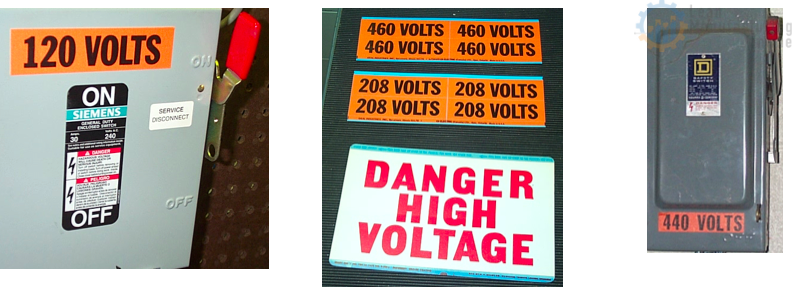
Basic Electrical Safety Awareness
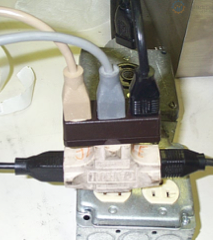
Overloading of outlets and extension cords
Overloading occurs when there is too many plugs into one outlet. It is a safety hazard and can result in overheating of the outlet and cause of electrical fire.
Checking electrical cords for damage and fraying
Damage can occur to electrical cords by pulling on cord instead of unplugging cord by the plug from the outlet. Electrical cords are NOT to be placed under rugs or floor mats, which can cause damage over time. Do not use devices with damaged cords or plugs.
Frayed wire usually occurs when electric cord is rubbing against moving parts and cuts through the insulation around the wire causing fraying of exposed wire.
What to do in case of electrical fire
If electrical equipment catches fire, unplug it if possible, or interrupt power at the main switch. Dial 0 and notify security of fire. If fire is small, use an ABC multi-purpose fire extinguisher on electrical fires. Never use water on electrical fire!
How shock occurs
Electricity seeks the easiest path to ground trying to find a conductor such as metal, wet wood or water. Since humans are 70% water, we make excellent conductors for electricity. If we touch an energized circuit while grounded, electricity will instantly pass through the body to the ground, causing a harmful, potentially fatal, shock.
Function and Use of Stops and Switches
Cycle Stops
When cycle stop is pushed it will light up red. The equipment will complete the cycle before stopping or coast to a stop. Its function is to stop the equipment in proper home or basic position. It does NOT bring the equipment to immediate zero energy state.
Emergency Stops
When emergency stop is pushed it will light up red. The equipment will immediately reach a zero energy state. Emergency stop removes all potential hazardous energy sources on equipment. It will stop equipment in mid cycle and is required to be pushed before entering the equipment.
Need for Lock-Out/Tag-Out (LOTO)
Lock-out/Tag-out of equipment protects you and other employees from the unexpected release of all sources of hazardous energy and protects the equipment from damage. Examples of hazardous energy include but not limited to:
- Electrical
- Mechanical
- Hydraulic
- Pneumatic
- Chemical
- Thermal
Hazardous energy also includes sources of potential stored energy. Potential stored energy includes but not limited to:
- Springs
- Compressed gases
- Suspended objects
Lock-out/Tag-out MUST be completed prior to performing maintenance, repair, cleaning. Failure to properly Lock-out/Tag-out could result in serious injury to you or others in the vicinity and could cause equipment damage.
Guard Safety Switches
There are two types of guard safety switches used in the plant. They are the magnetic switches where the blocks are connected to make the switch and the mechanical switches where units are plugged into each other making the connection. All guard safety switches act like an emergency stop and will shut down equipment in mid cycle.
Before opening any guard door the following procedure should be followed. Engage Cycle Stop and wait for equipment to come to rest, next engage E-Stop before opening guard door and entering the equipment.
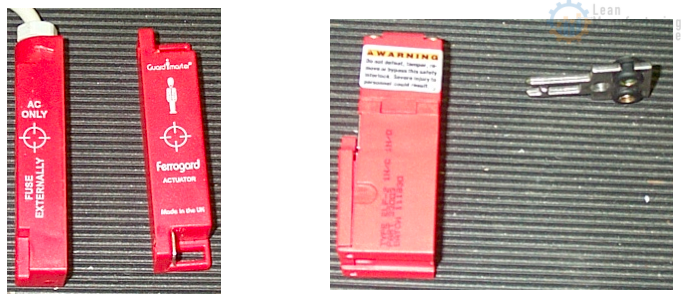
Photo Sensor Overview
Photoelectric sensors have an emitter element to generate a light beam, and a receiver element that receives the light beam. There are four components to all photoelectric sensors:
- Light emitter
- Light receiver
- Lens
- Output switch to PLC
Photoelectric sensors are designed to operate in one of three basic sensing modes.
- Sensing Modes
- Opposed sensing mode
- Retroreflective sensing mode
- Proximity or Diffuse sensing mode

Opposed Sensing mode
Opposed mode sensing is sometimes called the “beam-break” mode. The emitter and receiver are positioned opposite each other so that the sensing energy from the emitter is aimed directly at the receiver. An object is detected when it passes between the emitter and receiver and blocks the emitter’s light from reaching the receiver. Opposed mode sensing is the most efficient sensing mode and offers the highest level of sensing energy to overcome contamination and sensor misalignment.
Retroreflective Sensing mode
Retroreflective mode sensing is called the “reflex” mode.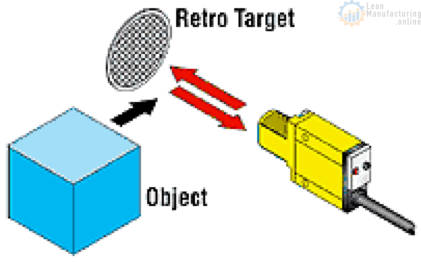 The emitter and receiver are in the same housing. The sensor is set up so that the emitter’s light beam strikes a reflective (“retro”) target, and is directed back to the receiver. An object is sensed when it passes between the sensor and the target, interrupting the light beam. A good retroreflector returns about 3,000 times as much light to its receiver. This is the most popular sensing mode for conveyor applications.
The emitter and receiver are in the same housing. The sensor is set up so that the emitter’s light beam strikes a reflective (“retro”) target, and is directed back to the receiver. An object is sensed when it passes between the sensor and the target, interrupting the light beam. A good retroreflector returns about 3,000 times as much light to its receiver. This is the most popular sensing mode for conveyor applications.
Proximity or “Diffuse” Sensing mode

Proximity mode sensing involves detecting an object that is directly in front of a sensor by detecting the sensor’s own transmitted energy reflected back from the object’s surface.
Both the emitter and receiver are on the same side of the object and usually together in the same housing. In proximity sensing mode an object actually “makes” (establishes) a beam, rather than interrupts the beam.
Ultrasonic Sensors
Ultrasonic sensors operate in either the opposed or proximity sensing mode. 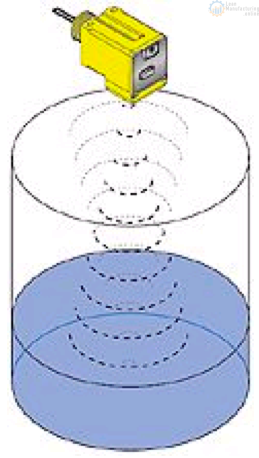
The ultrasonic sensor send “waves” of ultrasonic sound outward from the face of the transducer, and then receives “echoes” of ultrasonic waves that are located within its response pattern.
Remember that the efficiency of ultrasonic sensing depends upon the reflectivity of materials to sound waves, not light.
Ultrasonic sensors can detect certain transparent materials and very dark-colored materials that are difficult or even impossible to detect with photoelectric sensors.
Common Problems
Blocked or Dirty Lens
When photo sensors seem NOT to be functioning, Four steps should be taken:
- Clear sensor beam pathway.
- Clean photo lenses with dry cloth.
- Clean the reflector with dry cloth.
- Test again by blocking the beam.
Avoid using cleaning solutions containing alcohol because it can damage the lenses of most photo sensors.
Misalignment
Some photo sensors may get bumped, knocked out of alignment, or fasteners come loose holding the sensor in correct position and will not operate even after being cleaned.
Basic steps to take to adjust Sensors:
- Direct the sensor at target object or reflector.
- Move the sensor until the LED indicator comes on or goes off.
- Adjust sensor to capture “core” of object or reflector.
- Tighten fastener to keep sensor in correct position.
Inspection Criteria
The goal of inspection is to discover and act upon equipment deterioration before a breakdown occurs losing production time and incurring additional maintenance cost.
Inspection involves using 4 of the 5 senses to detect abnormalities:
- Visual – using sight to inspect equipment.
- Touch – to feel abnormalities.
- Sound – to hear equipment problems.
- Smell – to detect abnormal odors of equipment.
Frequent and thorough inspections will reveal small problems and defects such as:
- Loose wires, cracked conduit, frayed wires.
- Pulled apart plugs and Loose connections.
- Open or missing electrical covers.

Practical Exercises
Electrical and Sensor Knowledge
Skill Evaluation
Circle the correct answer or fill in the blanks.
- True or False Electrical and Sensor module will provide operators with necessary technical training to become electricians in the plant.
- Volt is the unit of electricity that measures?
- Current
- Pressure
- Amps
- All the above
- True or False It is okay to use damaged or frayed electrical cord as long as it is placed under rugs or mats.
- The correct procedure to shut down equipment is:
- Open door, Cycle stop, E-Stop
- E-Stop, Cycle stop, Open door
- Cycle stop, E-Stop, Open door
- Don’t shut down the equipment.
- Lock-out/Tag out is needed for which of the following?
- Electrical
- Mechanical
- Pneumatic
- Hydraulic, Chemical, Thermal
- All the above
- The four components of a Photo Sensor?
- Eye, Cord, Body, Reflector
- Light emitter, Light receiver, Lens, Output switch
- Device, Reflector, PLC, Object
- Light emitter, Lens, Reflector, Output switch
- Write the letter of the type of photo sensor mode under each of the diagrams.
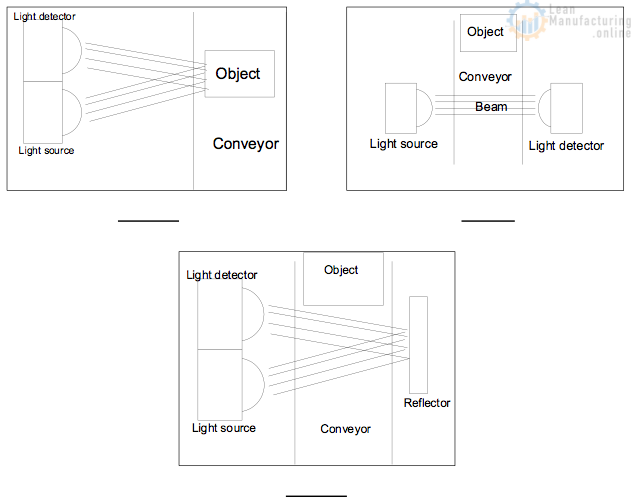
- A.) Proximity or Diffuse mode
- B.) Retroreflective mode
- C.) Opposed mode
8. What step do you take for a non-functioning sensor?
- Clear pathway
- Clean lenses
- Clean reflector
- Test again
- All the above.
9. How many steps are there to adjust a misaligned sensor?
- 4
- 3
- 5
- Do not adjust sensors.
10. True or False The goal of inspection is to discover and act upon equipment deterioration before a breakdown occurs.
Electrical and Sensor Competency
Skill Evaluation
| CRITERIA | SATISFACTORY COMPLETION |
| 1. Did the student understand proper
Lock-out/Tag-out procedures? |
YES NO |
| 2. Did the student verify the proper use of
Cycle stop and E-Stop? |
YES NO |
| 3. Did the student identify the
abnormalities on the cart? |
YES NO |
| 4. Did the student identify the Sensor
mode before adjusting? |
YES NO |
| 5. Did the student determine that the
photo sensor was not functioning? |
YES NO |
| 6. Did the student clean the photo
sensor? |
YES NO |
| 7. Did the student follow the steps in
adjusting the photo sensor? |
YES NO |
| 8. Did the student complete proper
housekeeping procedures when task was complete? |
YES NO |

